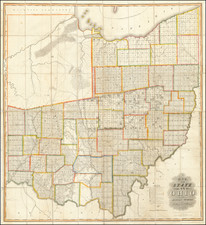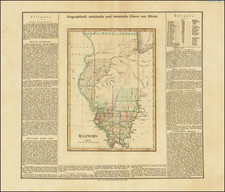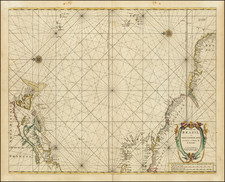De L’Isle’s Important Map of Northeast North America
Fine example of De L'Isle's seminal map of eastern Canada, the Great Lakes, and the Upper Midwest— one of the most important and influential maps of the region published in the eighteenth century.
First published in 1703, the first state of this map was one of the earliest to locate Detroit; it was issued only two years after the founding of the village by Cadillac. Additionally, it is of especial importance for a number of regions, including the Great Lakes and the Rocky Mountains. Kershaw states that the map is
One of the most outstanding maps of Canada of the 17th and early 18th Centuries . . . De L'Isle's careful research resulted in the first map of Canada to present the whole of the Great Lakes correctly. In addition, the position of the lakes relative to Hudson's Bay is also correct, and the Avalon Peninsula is shown much more realistically than on previous maps of Canada. Of considerable significance, the geography of the coastal regions of James and Hudson Bays, together with their major rivers systems, is presented by De L'Isle with a surprising degree of accuracy.
To the south, there is a series of lakes connected by a river, the Rivière longue, that leads to a western mountain range. Notes identify this feature as coming from the travels of the Baron de Lahontan. Lahontan distilled Native American reports of a great river, flowing to high mountains, with a great body of salt water beyond the mountains. This information was dubious at best, but it was integrated into many maps of this period. A large text block at the left discusses Lahontan and his findings. While Lahontan's Rivière longue proved mythical, the reference to and depiction of a mountain range here is believed to be the first depiction of the Rocky Mountains on a printed map.
Farther north, Hudson’s Bay, Baffin Bay, and Greenland are shown in detail, but with significant gaps in their coastlines. This area was still being explored; it was hoped that one of these gaps would lead to a Northwest Passage.
Notes describe the efforts of Arctic navigators such as Baffin and Davis. John Davis led three expeditions north, in 1585, 1586, and 1587. He sailed along the coasts of Greenland, Baffin Island, and Labrador, as well as charted the Davis Strait. He also found the entrance to Hudson Strait, which would be named for Henry Hudson thirty years later. William Baffin led an expedition to the bay now named for him in 1615 and 1616.
In addition to Arctic explorers and Lahontan, De L’Isle accessed other sources to make this map. De L'Isle studied at the French Ministry of the Marine from 1700 to 1703, during which time he took extensive notes on the work of the Jesuit missionaries, including Franquelin, Jolliet and others. These Jesuits in turn had gathered information from trappers and Indigenous informants. There is considerable inclusion of Indigenous names and settlements on this map.
Both missionaries and Indigenous peoples are referenced on the cartouche in the upper left. There are scenes of baptism and proselytizing, contrasted with a hunting party and a warrior holding a scalp. They are accompanied by a beaver and a goose, who flank the scale bars.
This is the scarce fifth state of the map, the first to include Buache's name, but it is otherwise unchanged from earlier editions.
The founding of Detroit
This map is significant for its early inclusion of the site of Detroit. On July 24, 1701, Antoine de la mothe Cadillac established a settlement on the strait, le détroit, between Lakes Erie and Huron. Cadillac was a French military man and a trader; he was also once the commander of Fort Michilimackinac at the junction of Lake Huron and Lake Michigan.
In 1698, Cadillac traveled to France to petition for permission to create a new outpost. By 1700, he had the support of the Minister of the Marine, Jérôme Phélypeaux Comte de Pontchartrain. A year later, in June, Cadillac mounted an expedition to locate the precise site for his new village. He called the fortress Fort Pontchartrain de détroit. Two days later, on July 26, the men began construction on a church named for St. Anne, as it was her saint’s day.
The village stayed small for its first few decades and was known as Fort Detroit. It became a British holding during the Seven Years War and began to grow considerably in the nineteenth century.
The Baron Lahontan and his travels, real and imagined
Louis-Armand de Lom d’Arce, the third Baron Lahontan, was a member of the aristocracy. Born in 1666, he was forced into a career in the military by the family’s hardship after his father’s death. He served across the Atlantic, in New France.
Lahontan was dispatched as part of a force who were to defeat the Iroquois tribes near the Great Lakes. In addition to, or perhaps instead of, his military duties he explored much of the upper Mississippi River Valley. While serving at Boucherville, Lahontan learned Algonquin. Later, he commanded Fort St. Joseph, on the site of what is now Detroit.
While Lahontan certainly saw a great deal of the Great Lakes region, in 1688 he set out on his most fantastic journey. So fantastic, in fact, that it is unclear whether or not it really happened. These travels included what he called the Rivière Longue, which some scholars believe was actually the Missouri River. He also reported a giant salt lake, around which the Tuhuglauk nation lived. However, Lahontan kept this strategically important detail secret while he served as Lieutenant-Governor in Placentia, Newfoundland and as he fled that position when faced with possible imprisonment.
In exile, Lahontan settled in the Netherlands in the mid-1690s, where he began to work on accounts of his travels. The first of these was Nouveaux Voyages dans l'Amerique Septentrionale (1703), which became a bestseller. It was printed in thirteen editions in fourteen years. This book included a description and map of the “Long River,” which was accepted and incorporated into the popular cartographic conception of the region by most of the leading mapmakers of the time, including Guillaume de L'Isle, Herman Moll, Henry Popple, and John Senex. The Tuhuglauk’s salt lake, in turn, would be combined with the geographic hypothesis of a Sea of the West.
Lahontan followed his 1703 memoir with two more, Memoires de l’Amerique Septentrionale, and Supplement aux Voyages ou Dialogues avec le sauvage Adario. Nouveaux Voyages dans l’Amerique Septentrionale. By the time he died, sometime before 1716, he was one of the most popular travel writers in Europe, despite the fact that many of his details were exaggerated or fictitious.
Guillaume De L'Isle (1675-1726) is probably the greatest figure in French cartography. Having learned geography from his father Claude, by the age of eight or nine he could draw maps to demonstrate ancient history. He studied mathematics and astronomy under Cassini, from whom he received a superb grounding in scientific cartography—the hallmark of his work. His first atlas was published in ca. 1700. In 1702 he was elected a member of the Academie Royale des Sciences and in 1718 he became Premier Geographe du Roi.
De L'Isle's work was important as marking a transition from the maps of the Dutch school, which were highly decorative and artistically-orientated, to a more scientific approach. He reduced the importance given to the decorative elements in maps, and emphasized the scientific base on which they were constructed. His maps of the newly explored parts of the world reflect the most up-to-date information available and did not contain fanciful detail in the absence of solid information. It can be fairly said that he was truly the father of the modern school of cartography at the commercial level.
De L’Isle also played a prominent part in the recalculation of latitude and longitude, based on the most recent celestial observations. His major contribution was in collating and incorporating this latitudinal and longitudinal information in his maps, setting a new standard of accuracy, quickly followed by many of his contemporaries. Guillaume De L’Isle’s work was widely copied by other mapmakers of the period, including Chatelain, Covens & Mortier, and Albrizzi.
Philippe Buache (1700-1773) was one of the most famous French geographers of the eighteenth century. Buache was married to the daughter of the eminent Guillaume Delisle and worked with his father-in-law, carrying on the business after Guillaume died. Buache gained the title geographe du roi in 1729 and was elected to the Academie des Sciences in the same year. Buache was a pioneering theoretical geographer, especially as regards contour lines and watersheds. He is best known for his works such as Considérations géographiques et physiques sur les découvertes nouvelles dans la grande mer (Paris, 1754).

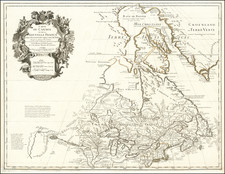








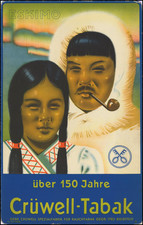
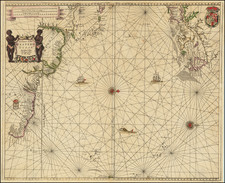
![Reize door de binnenlanden van Noord-Amerika, door Jonathan Carver . . . [with map:] Kaart van Capitein Carvers Reize in de binnenlanden van Noord-America in 1766 en 1767](https://storage.googleapis.com/raremaps/img/small/86685.jpg)
